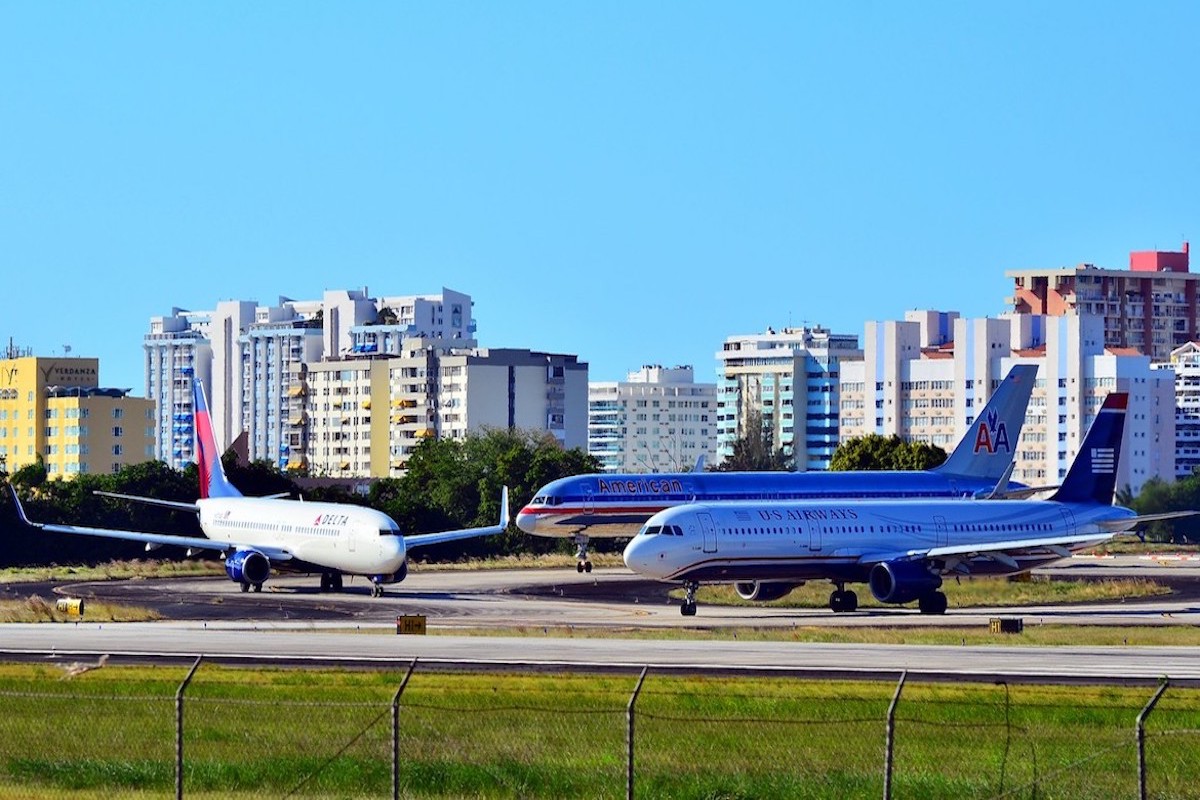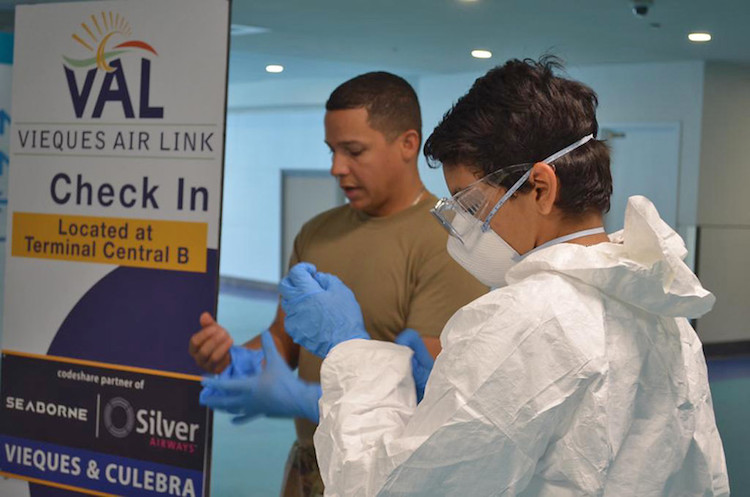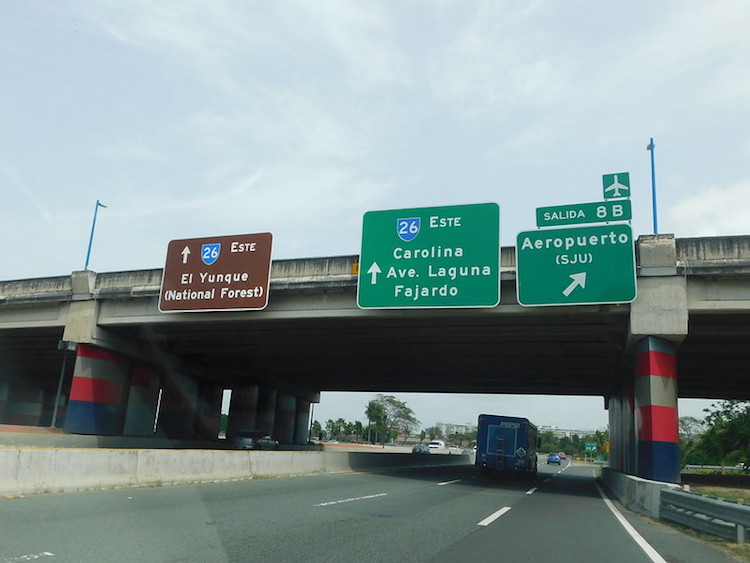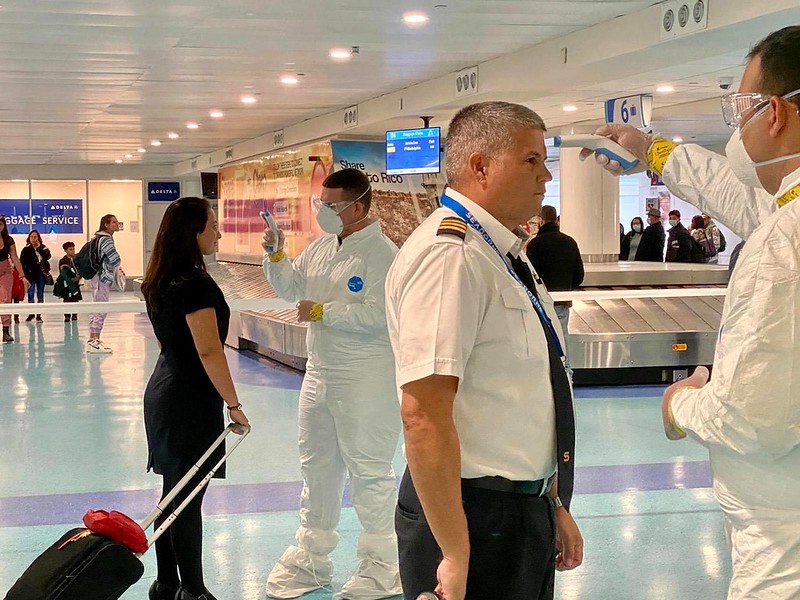

Although the flow of travelers from the areas of greatest spread of the virus in the United States has decreased, it has not stopped, putting the residents of Puerto Rico at greater risk. (Photo by TDelCoro on VisualHunt)
By Víctor Rodríguez Velázquez and Vanessa Colón Almenas
SAN JUAN, Puerto Rico — The spike of COVID-19 cases in regions with the highest concentration of Puerto Ricans living in the United States added to the historic volume of traffic of passengers arriving from those places through Luis Muñoz Marín International Airport, representing what could have been an open route for the virus’ transmission.
Epidemiology, public health, and infectious disease experts in Puerto Rico interviewed by the Center for Investigative Journalism (CPI, in Spanish) agreed.
Upon reviewing data of the areas of greatest COVID-19 infection in the United States, it appears that New York, New Jersey, and Florida are among the top 10 U.S. places of the virus’ spread. According to 2018 Census data, these three states are where the most Puerto Ricans live. Most of the flights that arrived at San Juan’s airport between March 8–17 came from these states, data analyzed by the CPI revealed.
“As the cases increased there [in New York, New Jersey, and Florida] and the flights to Puerto Rico continued, cases here were also going to increase. The flights should have been stopped from the beginning,” said Wanda Ortiz, president of the Puerto Rico Association of Epidemiologists. The first suspected case on the island was reported on March 8.
The second COVID-19-related death reported in Puerto Rico was that of a 73-year-old tourist from New York. The sixth death from the virus was a 68-year-old man who “began to develop symptoms after having close contact with someone in his family who had been to New York,” the Health Department said.
The Health Department gave little information about those infected during the first weeks but said at least three people had traveled to New York or Florida. The agency then stopped providing these details.
Ten days before March 17, 2020 —the day that the National Guard began taking the temperature of travelers at the airport— 2,491 commercial, private and cargo flights had arrived in Puerto Rico. Of those, 585 flights came from New York, New Jersey, and Florida — three states that since March 8, have been among the top 10 areas of virus outbreaks in the United States. Upon publication of the English version of this story on April 6 (see the original Spanish April 5 version here), the virus has claimed the lives of more than 74,000 people worldwide.
The CPI got the information of flights arriving in Puerto Rico from FlightAware, a company that keeps a database of records from air traffic control systems in more than 45 countries.
Héctor Cordero-Guzmán, PhD in sociology and demography, and professor at Baruch College at the City University of New York (CUNY), said it is important to analyze the spread of COVID-19 based on the flow of people that has historically existed between New York and Puerto Rico, through business, human, family and ideas interactions. An estimated 700,000 Puerto Ricans live in New York City, according to data from the Center for Puerto Rican Studies.
Alberto Velázquez, project manager of the Puerto Rico Institute of Statistics in charge of the Migrant Profile, said that between 2005 and 2018 in Florida, for example, there was an increase of 32,845 Puerto Ricans (277%) who moved there, according to the Census. In that same period, the number of passengers who traveled between Florida and Puerto Rico increased by 37% and flights from that state increased by 44%, according to data that Velázquez got from the U.S. Department of Transportation.


The screening of passengers at the Luis Muñoz Marín airport began on March 17. (Photo on VisualHunt)
Control Measures at Airport Lagged
Flor Rodríguez-Rivera, 45, living in Dorado, traveled to Michigan to spend two weeks caring for her nephew’s two children, after his wife had a cesarean delivery.
When she traveled alone on February 17 from the airport in Puerto Rico on a JetBlue airlines flight, she did not wear a mask or carried disinfectant. Neither did she do so when she returned on March 2. However, she noticed that in Boston, where she had a layover, people were already wearing masks.
Four days after her return to Puerto Rico, she felt a fever, sore throat and a cough. “It can’t be influenza, because I got vaccinated,” said Rodríguez-Rivera. She knew she would be with children and a baby, so she had taken precautions.
Her doctor did not see her. He told her to call the Puerto Rico College of Physicians and Surgeons. She got a brochure from them, but they did not tell her where to go. She called the phone number the Health Department published for those who had been to the Día Nacional de la Zalsa event.
“Stay at home,” is what the staff told her. “If you get worse, go to an emergency room.”
It got to the point where she had difficulty breathing. What Flor wanted was to get tested for coronavirus. “That’s only given to very bad cases and the tests don’t exist yet in Puerto Rico,” they told her when she called the Health Department’s help line again.
They repeated the hygiene rules that she knows exceedingly well, because she is an epidemiologist.
When she couldn’t breathe, she went to the Ramón Ruiz Arnau University Hospital (HURRA in Spanish), on March 16. She was wearing a mask. She had warned the hospital that she would be going there because she believed she had contracted the coronavirus. She stayed outside until a nurse finally led her to an isolation room.
They tested her for influenza and mycoplasma, took x-rays, and conducted a computed tomography (CT) scan. All negative. A doctor told her she could not be tested for coronavirus because the test was not available.
“If I were to test you, I would have to call the Health Department so that they send someone here and they’ll be the one to test you, but I have to consult with the regional epidemiologist,” Flor told the CPI.
On the other end of the phone line, you could hear that she was short of breath. She has fought cancer three times and has no thyroid. They never tested her for coronavirus.


(Photo by Jimmy Wayne via Visual Hunt)
Impact of Travelers Arriving to Puerto Rico Is Unquantified
The commercial and private flights that arrived between March 8- 17, 2020 from New York, New Jersey, and Florida had a maximum capacity of approximately 91,546 passengers, according to the models of planes that landed in Puerto Rico on those dates. But the CPI learned that in March some flights were almost empty. In that same timeframe, Puerto Rico received three flights from Madrid, Spain, one of the countries in Europe with the highest number of COVID-19 cases.
As of March 17, the number of passengers arriving in Puerto Rico decreased by 85% when compared to the number of weekly passengers arriving in Puerto Rico regularly, said Lt. Col. Paul Dahlen, public affairs officer for the National Guard.
Despite the drop, Gov, Wanda Vázquez-Garced acknowledged that the impact on transmission caused by travelers who had arrived in Puerto Rico from places with a wide presence of the virus is unknown.
Beyond promoting social distancing and requiring the population to stay at home, neither the Health Department nor the National Guard, which have been taking the temperature of passengers arriving at the island’s main airport, has traced the history of the people who arrived on those flights or those with whom they were in contact.
Lieutenant Colonel Dahlen confirmed the information to the CPI, saying the mission assigned to the military corps was to exclusively carry out the corresponding tests at the airport. He explained that they were not asked to trace people who arrived before or after the mission began.
He said Aerostar —the company that administers the airport— did not provide a list of all the flights nor the number of passengers that arrived in Puerto Rico between March 8–17, the day they began testing at the facility at 6 p.m.
The National Guard’s responsibility is to redirect suspicious cases (after a temperature is taken) to Health Department personnel who are stationed at the airport. The Health Department keeps records of people who have symptoms and who undergo COVID-19 tests, but not the rest of the asymptomatic passengers.
Aerostar did not provide that data the CPI requested on the number of flights and passengers that entered Puerto Rico from the three states with the highest frequency of trips before the National Guard began testing. Through its press spokesperson, Damarisse Martínez, the company said the staff responsible for documenting these statistics was sent home because it was not crucial in managing the coronavirus crisis. They did not answer why the data prior to March 17 was not provided, saying that Aerostar only supports the National Guard’s mission at the airport.
The CPI also asked the island’s Port Authority for information on the number of flights and passengers that had entered Puerto Rico between March 1-17, 2020. However, the agency said Aerostar only submits monthly reports.
Port Authority Executive Director Joel Pizá-Batis, who was unavailable for two weeks, did not confirm to the CPI if, due to the coronavirus epidemic, the government has asked Aerostar for daily reports on passenger movement at the airport. Martínez, meanwhile, said Aerostar had submitted reports much more frequently, but did not provide any of the data that she said was sent to Ports.
Epidemiologist Melissa Marzán-Rodríguez of the Ponce School of Medicine believes not following up on all passengers once they left the airport impeded from keeping the real count of a coronavirus presence in Puerto Rico.
“It’s one thing for the person to test positive and have no symptoms. [But] it’s also about tracing that person and to know who they had contact with. This epidemiological investigation must be done to contain the virus. In fact, you would need to call everybody on that flight to find out if they report symptoms once they are in Puerto Rico after 14 days, which is the maximum incubation period,” the expert said.
Marzán-Rodríguez noted that it is also undetermined how community transmission is taking place in those states—that is, the contagion among patients who have not had contact with a person who has traveled.
The Health Departments of Florida, New York, and New Jersey told the CPI that they do not have a breakdown on the nationality of the people with the infection, so they do not know how many Puerto Ricans have been infected with COVID-19 in their jurisdictions. The Centers for Disease Control and Prevention (CDC) document that is used to record cases under investigation only gives the options for establishing ethnicity (Hispanic/Latino) and race.
Not knowing about community transmission in these states limits the possibility of analyzing how many cases have actually been imported into Puerto Rico from those areas, the epidemiologist said.


As of April 2, the National Guard had taken the temperature of more than 45,000 people at the airport.
Another measure that Marzán-Rodríguez proposed was to halt flights arriving from areas with a large presence of cases of the virus but acknowledged that this determination is not in the hands of the local government.
On March 15, President Donald Trump announced a 30-day ban on the entry of tourists from 26 European countries considered COVID-19 risk points. The United States also restricted the entry of people who are in China and Iran. In a press conference last Tuesday, Trump announced he is also considering restricting flights to the United States from Brazil. Similar measures have been taken in other Latin American countries, such as Cuba and Colombia, where President Iván Duque announced a 30-day ban on international flights on March 19.
“If we continue to have sustained community transmission in New York, for example, which we know has a lot of exchange with Puerto Rico in terms of flights, then flights should be limited, and that’s not in the local jurisdiction’s hands. It would be about stopping flights during the quarantine. But the local government has no jurisdiction over that. If that’s not an option, we must continue to do the airport screenings and be able to identify those cases coming in, and that as soon as they arrive, they’re put in quarantine,” Marzán-Rodríguez said.
The expert recalled that, during the Ebola epidemic in 2014, certain airports in the United States were assigned to receive flights arriving from places with sources of infection. “At that time, the system included monitoring everybody who entered the United States through these routes for 21 days, which was the incubation period. It isn’t just doing the tests. There also has to be a responsibility to monitor, to be able detect COVID-19 cases early,” Marzán-Rodríguez said.
Carlos Rodríguez-Díaz, public health scientist and researcher at the University of Puerto Rico’s Medical Sciences Campus and George Washington University, agreed with the importance of these measures, considering asymptomatic people who may arrive on those flights.
“A person can be infected with COVID-19 and have no symptoms. There is a monitoring system at the entrance and exit at the airports and a person may have no symptoms and be a carrier of the virus and therefore can be a vector, that is, they can have the virus and transmit it to other people. Therefore, physical or social distancing, as it’s being called, is important, because we cannot depend on a person having symptoms to know if they have the infection or can expose others to the infection,” Rodríguez-Díaz explained.
Hundreds of Flights to Puerto Rico as Cases in New York, New Jersey, and Florida Increased
In Florida, where 1.1 million Puerto Ricans live, according to 2018 Census data, the first case was reported on March 1. Seventeen days later, that state registered 873 COVID-19 cases. Most of the positives were located in Broward County (214 cases), where about 88,000 Puerto Ricans live. That same week, 406 flights arrived in Puerto Rico from Florida without any preventive measures in place at the airport. As of April 6, there are over 13,000 positive cases in Florida and 254 deaths.
in New York, where a million Puerto Ricans live according to the Census, the first case was also registered on March 1. In 17 days, this state added 5,346 positive cases. In that same time interval, 94 commercial and private flights arrived in Puerto Rico from New York. The state recorded more than 130,000 positive cases, including more than 4,700 deaths, as of April 6.
In New Jersey, where the Census confirms more than 488,000 Puerto Ricans living there in 2018, the first two coronavirus cases were recorded on Mach 4 in Bergen County. During the week of March 8–17, 768 positive cases were registered in New Jersey and the county with the highest prevalence at that time —with 257 cases— was Bergen, where more than 34,000 Puerto Ricans reside. During that same week, 85 commercial and private flights arrived in Puerto Rico from that state. As of April 6, New Jersey recorded more than 41,000 positive cases and over 1,000 deaths.
But these flights are not just limited to Puerto Ricans who reside in those states and come to visit. The main airports in New York, Florida, and New Jersey serve as a stop-overs for travelers arriving from other points in the United States as well as from international flights. It’s also common that every year during the month of March, thousands of tourists from the United States come to Puerto Rico for Spring Break. In fact, during every March of the last four years, an average of more than 398,971 (400,000) passengers have arrived in Puerto Rico, according to information from the Port Authority that the Puerto Rico Institute of Statistics publishes.
This is why Marzán-Rodríguez stressed the urgency of activating monitoring protocols to keep track of all arriving travelers, mainly from areas with extensive cases of the virus.
From March 17 to April 2, National Guard officers took the temperature of 45,646 people at the airport. They were also screened for symptoms. Of the total, 153 travelers were referred to the triage area that the Health Department set up at the airport, and only 55 underwent the COVID-19 test. In total, 130 passengers were sent to home isolation, the government said.
The rest of those who did not go through the triage were released without taking their names and towns of residence. It was not until March 23 that the Governor recommended that everyone who arrives in Puerto Rico isolate themselves for a period of 14 days. That same day, the Federal Aviation Administration (FAA) approved redirecting air traffic to the island only to Luis Muñoz Marín Airport.
In addition, the FAA determined that all charter and general aviation aircraft (people who own light aircraft for recreational flights), from international destinations and from the United States, can only land at the Aguadilla, Isla Grande, and Isla Verde airports. Prior to that, those types of flights could land at the Culebra, Vieques, Ceiba, and Ponce airports.
Contact Tracing and Further Testing Is the Recommended Combination
Marzán-Rodríguez believes the uncertainty about the real number of coronavirus cases in Puerto Rico could also be corrected if the government of Puerto Rico ran more tests and expanded contact tracing to everyone who arrived on flights, regardless of whether they have symptoms or not.
For now, the Health Department tests people who have the three main symptoms associated with coronavirus —dry cough, fever, and shortness of breath— and who have been exposed to travel or to someone who has been traveling. The possibility of doing the tests was expanded to include medical criteria, that is, if they think the person should be tested.
But Marzán-Rodríguez, a public health scientist, said expanding the tests could help better monitor the epidemic, but admitted the government has limited resources.
“We know there aren’t enough tests available and they’re taking precautionary measures so there are tests available for the people who really need them. There is certainly evidence that there aren’t enough tests, which is a problem when performing epidemiological analyses of the disease in Puerto Rico. With the pattern we have so far, it’s likely that we’ll never know how many people are being infected, we’ll only know about the people who are being tested,” Marzán-Rodríguez said.
The World Health Organization (WHO) is also promoting further testing and contact tracing as measures to mitigate the expansion of COVID-19, since, according to its Director General, Tedros Adhanom, limiting precautionary measures to quarantines and social distancing helps only to buy time but not to “extinguish an epidemic.”
He also said governments should expand and deploy more health care and public health personnel, which, in turn, allows tracing of all suspicious cases that could affect community transmission.
Health Secretary Lorenzo González said at a press conference last Tuesday that contact tracing involves putting together groups that will be deployed to the eight epidemiological regions and that will require fleets of cars to move to communities to identify hotels in the zones in case someone needs to be isolated.
The Governor’s COVID-19 Task Force defines contact tracing as “an interview with people who have probable or positive results with the goal of identifying those people who may have been high-risk or close contacts.”
In written statements, epidemiologists Cynthia Pérez, Enid Díaz, and Juan Carlos Díaz, all part of the Task Force, explained that “the support in the regions initially comes from personnel from other Health Department programs, which includes epidemiologists and nurses.”
They did not specify how many people will support each region, since “it will depend on the region and the number of cases that are being handled.” The doctors also recommended that each regional team be staffed also with volunteers.
However, the measures to trace people who may have been in contact with someone who carries the coronavirus would be limited to cases in which patients have tested positive for the disease and not to all the people who arrived on a flight to Puerto Rico.
The Health Department’s COVID-19 Preparedness and Response Plan confirms this. The plan only establishes that as a precautionary measure, only high-risk travelers can be quarantined in their home, place of stay or in an alternate location.
“Each quarantined individual will be monitored daily by phone, text or in person to validate whether there’s fever and other characteristic symptoms of COVID-19,” the document states. The document does not include any measure related to follow-ups to the rest of the passengers who arrive on flights and who could carry the virus asymptomatically. In addition, the plan does mention contact tracing in general, but only when it comes to “suspicious” contacts.
This description of the contact tracing does not propose a specific protocol of the waiting time before an intervention or inquiry is done of people in contact with the case, the possible COVID-19 carrier. It only indicates that contact tracing would begin “as soon as possible,” after the person who might have the virus is interviewed.
Contact tracing is part of the rapid surveillance strategy, consisting of reports from hospitals, laboratories, other health and medical services facilities, and of deaths from COVID-19. Although the Task Force makes its recommendations, the Health Department is in charge of implementing it and deciding when it begins.
As of April 6, there have been 513 positive cases of coronavirus and 21 COVID-19 deaths in Puerto Rico, according to the Health Department. However, the agency reported that only 4,951 tests have been performed, of which 3,432 have been negative and 1,000 results are pending.



I am simply waiting for the FEDs arrive to charge the governor; governor Wanda Vazquez!
[…] Editor’s Note: The April 8 announcement about flights from Gov. Wanda Vázquez came three days after an April 5 story by Puerto Rico’s Centro de Periodismo Investigativo detailed how many flights were arriving to the island from states like Florida, New York and New Jersey in March. An English version of that story is here. […]